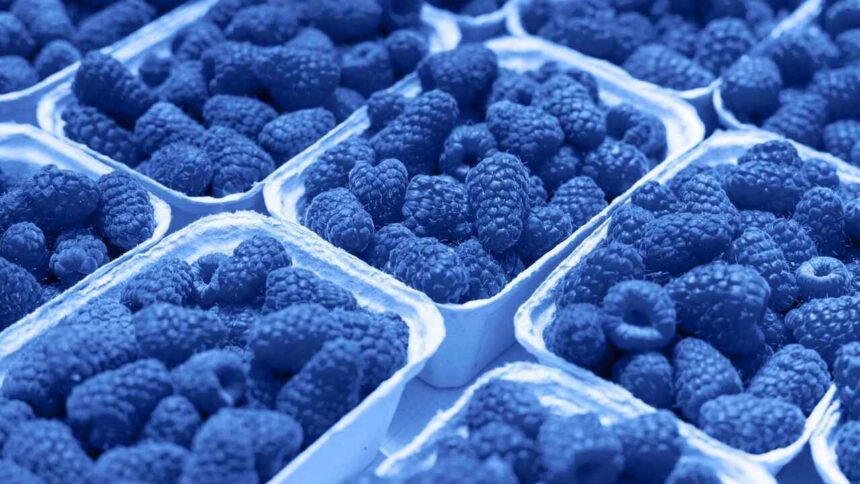“Blue raspberry” is a flavour that sparks curiosity and nostalgia in equal measure. Found in various treats, from slushies to candies, this vibrant blue flavour has become a staple in confections and beverages. However, its origins are more complex than one might think. What exactly is blue raspberry? Is there a real fruit behind this flavour, or is it purely a product of food science? In this detailed exploration, we’ll dive into blue raspberry’s history, science, and cultural impact, unravelling the mystery behind this beloved flavour.
The Origins of Blue Raspberry
The story of blue raspberry begins not with fruit but with a colour—specifically, a need to replace a controversial dye. In the 1970s, Red No. 2, also known as amaranth, was a popular food colouring used in many raspberry-flavoured products. However, concerns about its safety led to its eventual ban by the U.S. Food and Drug Administration (FDA) in 1976. This ban challenged food manufacturers who relied on the red hue to signify raspberry-flavored products.
To fill the gap left by Red No. 2, food scientists turned to Blue No. 1, also known as Brilliant Blue FCF. This synthetic dye had already been approved by the FDA and provided a vibrant, eye-catching alternative. Combining this blue dye with a raspberry-like flavour profile gave birth to what we now know as blue raspberry. Interestingly, this flavour first gained popularity in products like snow cones and slushies, with the iconic ICEE slushie leading the charge in the 1970s.
The Science Behind Blue Raspberry
Blue raspberry is not derived from a natural blue fruit despite its name. Instead, it is a product of careful flavour engineering. The flavour is created by blending various esters—organic compounds imparting fruity aromas and flavours. Key esters used in blue raspberry flavouring include ethyl butyrate and ethyl acetate, which create a taste reminiscent of raspberries with a unique twist. This blend of flavours combines citric acid to give it the characteristic tartness many associate with raspberries.
The blue colour of blue raspberry products is achieved using food dyes like Blue No. 1. This dye, along with Indigo Carmine, is responsible for the vibrant blue hue that distinguishes blue raspberry from other fruit flavours. The choice of blue was practical and strategic—it provided a clear visual distinction from other raspberry flavours, particularly the red varieties that were common before the ban of Red No. 2.
Blue Raspberry in Popular Culture
Over the decades, blue raspberry has become more than just a flavour; it has become a cultural icon. Its vibrant colour and sweet-tart taste have made it a favourite in candies, slushies, and even cocktails. Products like blue raspberry Jolly Ranchers, Airheads, and Slurpees have solidified the flavour’s place in the pantheon of iconic confectionery flavours.
Beyond the world of sweets, blue raspberry has found its way into popular culture, appearing in music, movies, and media. Its association with childhood nostalgia and playful indulgence has made it a symbol of whimsy and creativity. The bright blue colour, in particular, has made blue raspberry a visually appealing choice for marketers looking to capture the attention of young consumers.
Is Blue Raspberry Real? The Myth and Reality
One of the most common questions about blue raspberry is whether it is based on a real fruit. The answer is both yes and no. While there is no naturally occurring fruit with the bright blue colour of blue raspberry products, the flavour does have a basis in reality. Blue raspberry is loosely inspired by the blackcap raspberry (Rubus occidentalis), a variety of raspberry with a deep purple hue that can appear almost blue when ripe. However, this connection is more about inspiration than direct derivation. The blue raspberry flavour we know today is a creation of food science rather than a product of nature.
The Enduring Appeal of Blue Raspberry
What about blue raspberry? Has it been allowed to endure for so long? Part of its appeal lies in its uniqueness. Combining a familiar fruit flavour with an unexpected colour creates a sense of novelty and fun. This novelty is particularly appealing to children, but it also resonates with adults who have fond memories of enjoying blue raspberry treats in their youth.
Moreover, the versatility of blue raspberry as a flavour has contributed to its staying power. It can be found in everything from candies and drinks to lip balms and air fresheners. Its distinctive colour also makes it a popular choice for themed parties and events, where it adds a playful and vibrant touch.
Conclusion
In the end, blue raspberry is a flavour that defies simple categorization. It is both a product of necessity—a solution to the problem of a banned dye—and a triumph of creativity, blending science and imagination to create something entirely new. While it may not be a natural fruit, blue raspberry has earned its place in the world of flavours, capturing generations’ hearts and taste buds. Blue raspberry symbolizes fun, nostalgia, and innovation whether you enjoy it in a slushie, candy, or a cocktail.
FAQs
Is blue raspberry based on a real fruit?
No, blue raspberry is not based on a naturally occurring fruit. It is a synthetic flavour inspired by the blackcap raspberry, which has a deep purple hue.
Why is blue raspberry blue?
The blue colour comes from synthetic dyes like Blue No. 1, which were used as an alternative to the banned Red No. 2 dye.
When was blue raspberry first introduced?
Blue Raspberry gained popularity in the 1970s by introducing products like the ICEE slushie.
What does blue raspberry taste like?
Blue raspberry has a sweet-tart flavour reminiscent of raspberries but with a unique twist, thanks to the blend of esters used in its creation.
Why is blue raspberry so popular?
Its popularity stems from its unique combination of a familiar flavour with an unexpected colour and its versatility in various products like candies and drinks.
Also Read: The Legacy of Iconic Hollywood Fast Food Restaurants: Where History Meets Quick Bites






